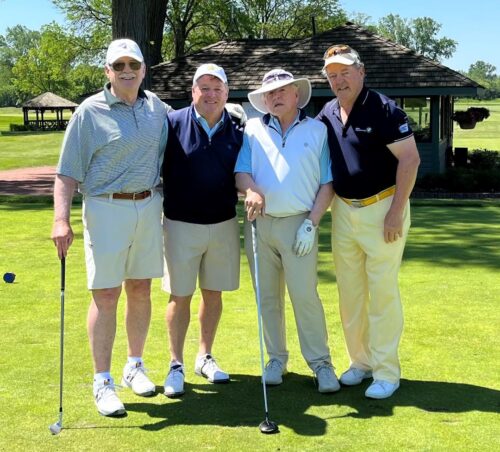Skokie Country Club Has Plenty to Celebrate: Its Founding and Its U.S. Open Centennial
By David A. F. Sweet
Every quarter century or so, private clubs celebrate a meaningful anniversary. In the Chicago area, many golf clubs — from Exmoor to Glen View — have been commemorating their sesquicentennials (also known as 125th anniversaries).
But one this year has toasted not one but two major commemorations. Skokie Country Club in Glencoe is not only 125 years old; a century ago, it hosted the U.S. Open.
A 20-year-old Italian immigrant, Gene Sarazen, bested Bobby Jones and John Black by one stroke in 1922. On the par-5 18th hole, Sarazen hit a driver from the fairway onto the green and two-putted for a birdie to capture the championship. The area where he struck that shot with the club (not known for its fairway prowess) is marked by a plaque on the course today.

Gene Sarazen and his caddy celebrate the golfer’s first major during the U.S. Open at the Skokie Country Club.
That started a love affair between Skokie and Sarazen, whose 1922 win marked his first major. At age 95, he returned to the club for its 100th anniversary, and his daughter, Mary Ann Sarazen, has donated her father’s memorabilia that is showcased near the men’s locker room. The winners of the Sarazen Cup at Skokie are awarded admissions badges to the following year’s Master tournament, thanks to Mary Ann.
That U.S. Open was significant for another reason. British Open winner Walter Hagen brought the Claret Jug to Skokie, and it was the first time it snuggled by the U.S. Open trophy. Hagen’s win had been a milestone; he was the first U.S.-born champion of the British Open. Not only that, the 1922 U.S. Open was the first one to charge for admission — a whole dollar.
Founded in 1897, Skokie became the fifth private golf course in Chicago. It exists because of the development of the Exmoor Country Club and the Glen View Club, both in 1896. Since Exmoor was a short train ride from Glencoe and Glen View was a short train ride from Chicago, people who lived in Glencoe and/or worked in Chicago gravitated to those two clubs once they opened.
But James Calhoun, who lived by a large expanse of open land in Glencoe, thought differently. He didn’t understand why he would take a train to Exmoor when he could build a club across the street. He gathered eight others as founders, and the Skokie Country Club was born.
By May 1898, the new club already had 117 members. They added about 60 more in 1899. As the years progressed, Golden-Age architects were involved with the course: H.J. Tweedie and George Leslie are credited with developing the original nine, while Tom Bendelow expanded the course to 18 holes in 1905. Four years later, Skokie hosted the Western Open — considered to be the best tournament after the U.S. Open and the British Open.
But there was one major problem: Skokie’s ninth hole finished 500 yards away from the clubhouse, prompting grumbling from members who were forced to walk up a hill back to the clubhouse after finishing. A fourth Golden-Age architect, Donald Ross, was brought in. He made sure the ninth and 18th greens ended by the clubhouse while reversing many of the Bendelow holes — meaning Bendelow greens became Ross’s tee boxes, and Benedlow tee boxes became Ross’ greens.
Aside from the 1938 William Langford-Theodore Moreau rearrangement — which is the routing golfers play today — the course stayed mostly the same until the 1990s, when Skokie brought in a handful of architects to assess it. All of them said too many trees of the 3,000 on the course blocked shot options, and the greens were getting too small. Not only that, during rains of half an inch or more, the sand faces of Skokie’s bunkers washed down, and it would take 100 man hours to push them back up. The bunkers were also considered out of character with the original style.
Skokie hired classical architect Ron Prichard. Committee members toured the Essex Country Club in Massachusetts, a Donald Ross course he had restored.
“Our committee fell in love with the naturalness of the club. They even had blueberry bushes growing on the side of bunkers,” said Superintendent Don Cross, a 31-year veteran of Skokie.
Eventually, 250 trees at Skokie were removed — (‘people were worked up about that,” Cross recalled) — and new bunkers installed. But today, those bunkers need to be replaced since the sand is contaminated. In a project started in August, Skokie plans to go from 100,000 square feet of sand traps to 130,000 square feet when Brian Schneider restores the 122-acre course.
Teeing off on the first hole today is a pleasure. Up high on the box similar to the first at Riviera Country Club, golfers can look down not only the first fairway but the 10th (both designed by Ross). Those who end up on the wrong fairway are often able to reach the right green on the next shot. When the Western Amateur arrives in 2025, golfers on the 13th hole will strike their drive above the heads of those putting on the 12th — likely the only tee box so situated in the country.
And you may want to know: Why is a country club in Glencoe called Skokie? As Don Potter, member and author of The History of the Skokie Country Club, explained, “Skokie means wet prairie. We borrowed the Potawatami Indian term to reflect the wetlands where we built the course.”
David A. F. Sweet is the author of Three Seconds in Munich about the 1972 Olympics. Contact him at dafsweet@aol.com.









